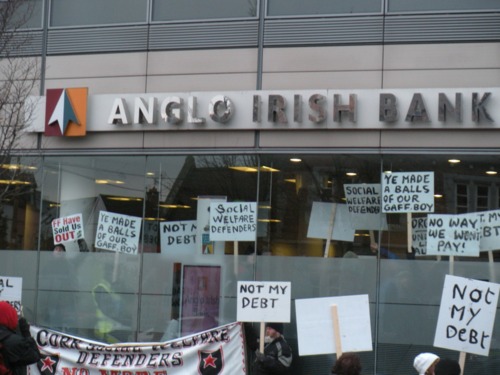What’s next for Occupy Everything?
If you’ve been watching at home, you know the showdown with our lady finance only gets good when state force whisks her to safety behind a cloud of pepper spray. Wednesday night at Wall Street, the NYPD insisted on living up to its reputation by conjuring violent conflict out of peaceful thin air. Beatings, poison, and arrests greeted attempts to set foot on the cobblestones that bankers would tread easily come morning, and we all chanted “shame, shame, shame” as more and more buses rolled through with enough empty seats for everyone singing at the gates of finance.
On the first day of the occupation, while the nascent protest was getting acquainted with itself in the park, I had strolled up to Liberty Plaza from Bowling Green, past the stock market’s barricaded golden calf, and then past twenty or so cops packed shoulder to shoulder in front of Wall Street. A female tourist was smiling in front of them, getting her picture taken. Nineteen days later, the occupation at those gates was a beautiful, complicated thing, peaceful even in the face of mass arrests. Every night people sleep on the street to deny Wall Street the implicit consent that Americans have offered since long before TARP.
If you want to read about some of the people who have come to do this work, look here orhere, or lots of other places. Better, visit the “We are the 99 Percent” Tumblr. If you have not yet gone to Liberty Plaza in New York or your nearest occupation, it is so profoundly time to go join these people. Having tangled with sectarians and lived to complain endlessly about it, I understand what some people fear. And in the last couple weeks, I have read and heard every reason under the sun why these people are silly, why they’re different from you and me and the “real” working class. I won’t engage in such meticulous sorting of the exploited here. Go down. If you hate inequality, if you hate plutocracy, if you’ve marched, chanted, and thrown yourself against exploitation any time in the last eight decades, for god’s sake go. Bring tarps.
If you’re reading this, you probably receive unreasonably large numbers of emails from left-wing activist organizations, and every one of them has been dispatching the same headline for days: #OccupyWallStreet. The occupation has already done a service in connecting these groups, as Mark Engler noted here. That ubiquitous hashtag marks a movement born with the internet in mind. McKenzie Wark has written about the effective occupation of internet territory and the media. The occupation is building bit by bit, spreading to cities from Boston to L.A. to Houston.
The media has begun to ask hungrily, “What’s next?” It’s often an apprehensive question directed at a quasi-movement that has managed to escalate in size and tension every week. The seven hundred arrests on the Brooklyn Bridge last Saturday drew attention way beyond the best organized union march. Police brutality continues to trigger coverage, and by blockading Wall Street on Wednesday, they set up another site of confrontation.
The most spectacular show of force came when a large group decided to march away from Wall Street, and wind back toward it, later Wednesday night. “Whose streets? Our streets!” we shouted as the police corralled us onto the sidewalk. We walked through dark streets on narrow sidewalks, hemmed in by a line of motorcycle cops so close together that sometimes they bumped wheels. More officers ran alongside. And on our other side, officers stood in doorways holding nightsticks. “Police! Join us! They want your pensions too!” There were helicopters. Little wildcat marches reportedly made their way through the streets too, confronting the police as they sought an approach to Wall Street. This scene was a good reminder of the abundant potential to create news coverage by stepping peacefully out of line. And it’s starting to look like there is a critical mass of people ready to make headlines out of taxpayer-funded cops keeping New Yorkers from directly protesting the banks that they bailed out.
Maybe it’s time to start sitting down inside those banks. #OccupyLA has already tried this, and members got arrested after trying to cash a $673 billion dollar check to “the people of California.” The police barriers are temporary; the banks are there to confront every day in every city. Occupy Wall Street has gained more traction every time the occupation has escalated. And it’s currently more popular than Congress. If there was ever a time to radicalize American onlookers, this is it. Organizations in the larger struggle against inequality who can’t afford civil disobedience, like many unions, should follow Stephen Lerner’s recent advice and lend support to members of the 99 Percent who can.
Sit-ins come with their own problems. #Occupy has been successful in part because of the expansiveness of its “no demands” assault on what has been a consequence-free, top-down class war. But can you sit-in without demands, the fulfillment of which would cause you to leave? Might we demand the impossible, bailing out the people with large-scale debt cancellation, or a constitutional amendment to delineate the hard and fast difference between money and speech? And why target banks, when it’s the government that failed to regulate them? But these sorts of caveats may be well beside the point.
As the occupation has escalated, it has attracted new people, and it has grown not only in size, but ideologically. It is still evolving, but staying in motion is crucial, as is keeping the focus where it belongs: on the banks that screwed us all, and then took our money a second time to stay in business. It might be time to pay them a real visit.
Sarah Leonard is an editor at The New Inquiry. This piece originally appeared at the Dissent blog.
